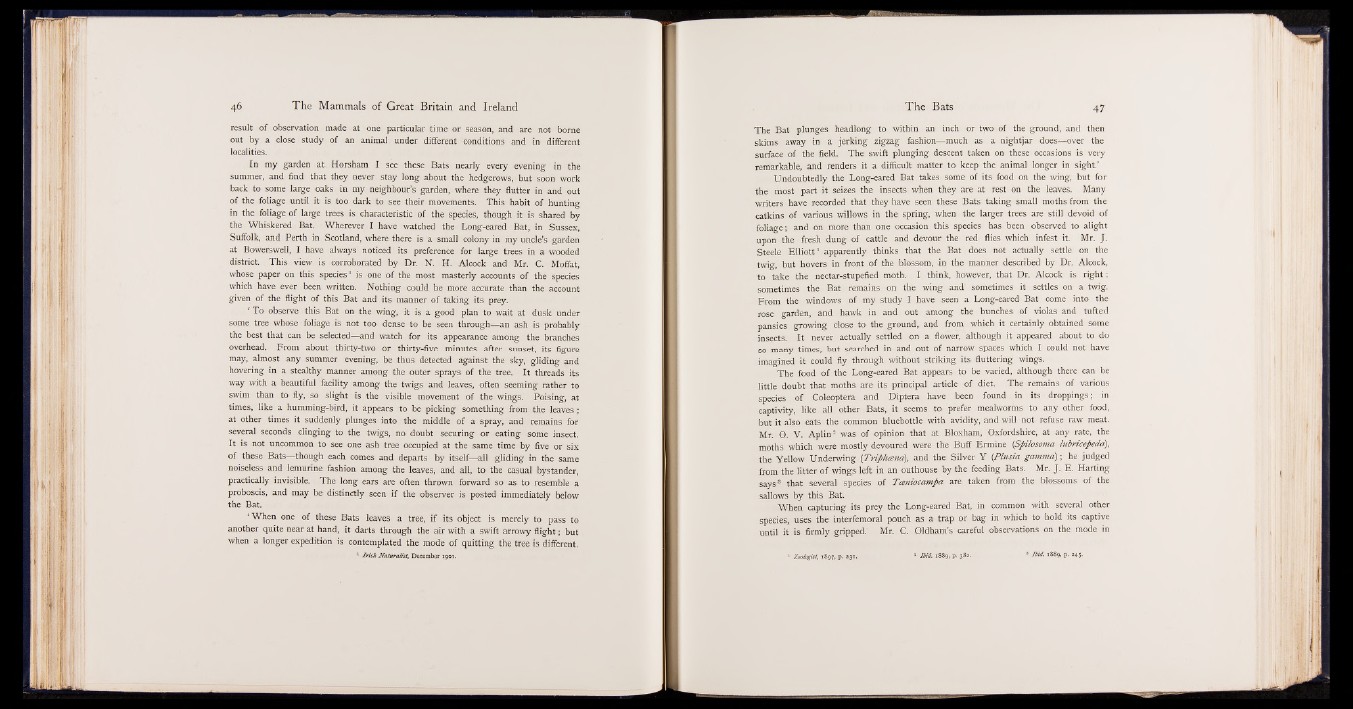
result of observation made at one particular time or season, and are not borne
out by a close study of an animal under different conditions and in different
localities.
In my garden at. Horsham I see these Bats nearly every evening in the
summer, and find that they never stay long about the hedgerows, but soon work
back to some large oaks in my neighbour’s garden, where they flutter in and out
of the foliage until it is too dark to see their movements. This habit of hunting
in the foliage of large trees is characteristic of the species, though it is shared by
the Whiskered Bat. Wherever I have watched the Long-eared Bat, in Sussex,
Suffolk, and Perth in Scotland, where there is a small colony in my uncle’s garden
at Bowerswell, I have always noticed its preference for large trees in a wooded
district. This view is corroborated by Dr. N. H. Alcock and Mr. C. Moffat,
whose paper on this species1 is one of the most masterly accounts of the species
which have ever been written. Nothing could be more accurate than the account
given of the flight of this Bat and its manner of taking its prey.
‘ To observe this Bat on the wing, it is a good plan to wait at dusk under
some tree whose foliage is not too dense to be seen through— an ash is probably
the best that can be selected— and watch for its appearance among the branches
overhead. From about thirty-two or thirty-five minutes after sunset, its figure
may, almost any summer evening, be thus detected against the sky, gliding and
hovering in a stealthy manner among the outer sprays of the tree. It threads its
way with a beautiful facility among the twigs and leaves, often seeming rather to
swim than to fly, so slight is the visible movement of the wings. Poising, at
times, like a humming-bird, it appears to be picking something from the leaves;
at other times it suddenly plunges into the middle of a spray, and remains for
several seconds clinging to the twigs, no doubt securing or eating some insect.
It is not uncommon to see one ash tree occupied at the same time by five or six
of these Bats— though each comes and departs by itself—all gliding in the same
noiseless and lemurine fashion among the leaves, and all, to the casual bystander,
practically invisible. The long ears are often thrown forward so as to resemble a
proboscis, and may be distinctly seen if the observer is posted immediately below
the Bat.
‘When one of these Bats leaves a tree, if its object is merely to pass to
another quite near at hand, it darts through the air with a swift arrowy flight; but
when a longer expedition is contemplated the mode of quitting the tree is different.
1 Irish NaturaUsty December 1901.
The Bat plunges headlong to within an inch or two of the ground, and then
skims away in a jerking zigzag fashion— much as a nightjar does— over the
surface of the field. The swift plunging descent taken on these occasions is very
remarkable, and renders it a difficult matter to keep the animal longer in sight.’
Undoubtedly the Long-eared Bat takes some of its food on the wing, but for
the most part it seizes the insects when they are at rest on the leaves. Many
writers have recorded that they have seen these Bats taking small moths from the
catkins of various willows in the spring, when the larger trees are still devoid of
foliage; and on more than one occasion this species has been observed to alight
upon the fresh dung of cattle and devour the red flies which infest it. Mr. J.
Steele Elliott1 apparently thinks that the Bat does not actually settle on the
twig, but hovers in front of the blossom, 4n the manner described by Dr. Alcock,
to take the nectar-stupefied moth. I think, however, that Dr. Alcock is right:
sometimes the Bat remains on the wing and sometimes it settles on a twig.
From the windows of my study I have seen a Long-eared Bat come into the
rose garden, and hawk in and out among the bunches of violas and tufted
pansies growing close to the ground, and from which it certainly obtained some
insects. It never actually settled on a flower, although it appeared about to do
so many titties, but searched in and out of narrow spaces which I could not have
imagined it could fly through without striking its fluttering wings.
The food of the Long-eared Bat appears to be varied, although there can be
little doubt that moths are its principal article of diet. The remains of various
species of Coleoptera and Diptera have been found in its droppings; in
captivity, like all other Bats, it seems to prefer mealworms to any other food,
but it also eats the common bluebottle with avidity, and will not refuse raw meat.
Mr. O. V. Aplin2 was of opinion that at Bloxham, Oxfordshire, at any rate, the
moths which were mostly devoured were the Buff Ermine {Spilosoma lubricepeda),
the Yellow Underwing (Triphama), and the Silver Y {Plusia gamma);;.he judged
from the litter of wings left in an outhouse by the feeding Bats. Mr. J. E. Harting
says8 that several species of Tczniocampa are taken from the blossoms of the
sallows by this Bat.
When capturing its prey the Long-eared Bat, in common with several other
species, uses the interfemoral pouch as a trap or bag in which to hold its captive
until it is firmly gripped. Mr. C. Oldham’s careful observations on the mode in
1 Zoologist, 1897, p. 231. 2 Ibid. 1889, p. 382. 3 i 889> P- 245-